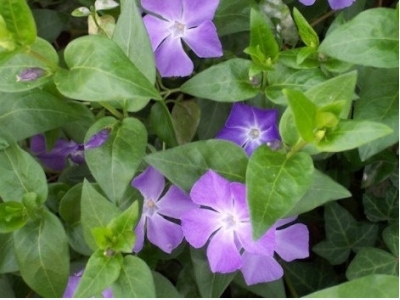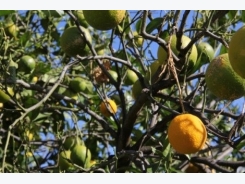How to Grow Periwinkle (Vinca)

Common periwinkle (Vinca minor) is an ideal plant for tough spots. It is also called lesser periwinkle or creeping myrtle.
Although it prefers rich, slightly moist soil, it tolerates a wide range of conditions, including clay, alkaline soils and drought. Periwinkle has shallow, spreading, fibrous roots that hold soil in place. Use it on slopes or to prevent soil erosion.
Native to Asia and Europe, periwinkle is hardy in U.S. Department of Agriculture plant hardiness zones 4 through 9. It blooms best in full sun, but it also grows in shade and is often planted under trees. Its dense roots tend to crowd out other plants, so use it alone or plant it with bulbs. Periwinkle produces tiny purple, blue or white blooms in spring to summer and has deep green, glossy evergreen foliage.
Planting and Caring for Periwinkle
Periwinkle can be grown from seed, but it grows slowly. A better bet is to use divisions or nursery transplants. Just a few plants will spread to fill in a large area. Enrich the soil with compost, manure and peat moss to improve drainage before planting. Plant periwinkle in either sun or shade. In cold, harsh climates, protect it from wind and water it when the temperature is above freezing to prevent winter burn.
Periwinkle grows 3 to 6 inches tall and 2 feet wide. Space plants at least 12 to 18 inches apart. Plant out periwinkle in spring or early fall. Water the soil deeply after planting and keep the soil evenly moist during the first 6 to 10 weeks, as the roots become established.
Fertilize periwinkle in spring with ¼ cup 10-10-10 fertilizer per 100 square feet of soil. Mulch dry soils to conserve moisture. Dig up and discard plants that grow out of bounds to contain periwinkle, especially if your soil is moist and rich. You can even mow periwinkle in spring if it begins to look straggly. Set the mower blade to its highest setting.
Vinca Pest and Disease Potential Problems
Although periwinkle is a long-lived plant, it can suffer from many diseases, especially in humid, wet climates. In wet soil, periwinkle suffers canker or root rot. Add soil amendments to improve drainage and remove and discard infected plants.
Botrytis blight can also be a problem. Characterized by leaf spots, dying leaves and dying or disfigured flowers, this fungal disease is most prevalent in cool, moist conditions. You can use a fungicide, such as copper or sulfur, to treat it, but prevention is the best strategy. Avoid planting periwinkle too closely and thin out the plants from time to time. Use drip systems, rather than overhead sprinklers, because wet leaves can spread the disease. Remove any diseased plants promptly and discard dead plant material.
Periwinkle can also suffer from leaf spots and aster yellows. Treat these conditions as you would botrytis blight. Allow good air circulation between plants, water them carefully and keep the garden clean.
One final note about periwinkle: once it becomes established, it’s difficult to eradicate. Plant it in a permanent location and don’t let it become invasive.
Varieties Worth Trying
- Vinca minor ‘Alba’ is a periwinkle variety that produces tiny, white flowers.
- Vinca minor ‘Atropurpurea’ has dark purple flowers.
- Vinca minor ‘Bowlesii’ has a vigorous, clump-like growth and produces large, dark blue flowers that are showier than most.
- Vinca minor ‘Flore Pleno’ is one of the few periwinkles that have double flowers. The flowers are purple.
- Vinca minor ‘Variegata’ has blue flowers like most vincas, but its outstanding feature is its variegated green and yellow foliage.
Có thể bạn quan tâm
Phần mềm

Phối trộn thức ăn chăn nuôi

Pha dung dịch thủy canh

Định mức cho tôm ăn

Phối trộn phân bón NPK

Xác định tỷ lệ tôm sống

Chuyển đổi đơn vị phân bón

Xác định công suất sục khí

Chuyển đổi đơn vị tôm

Tính diện tích nhà kính

Tính thể tích ao hồ



 How to Grow Acacia Tree
How to Grow Acacia Tree  Common Diseases of Orange Trees
Common Diseases of Orange Trees